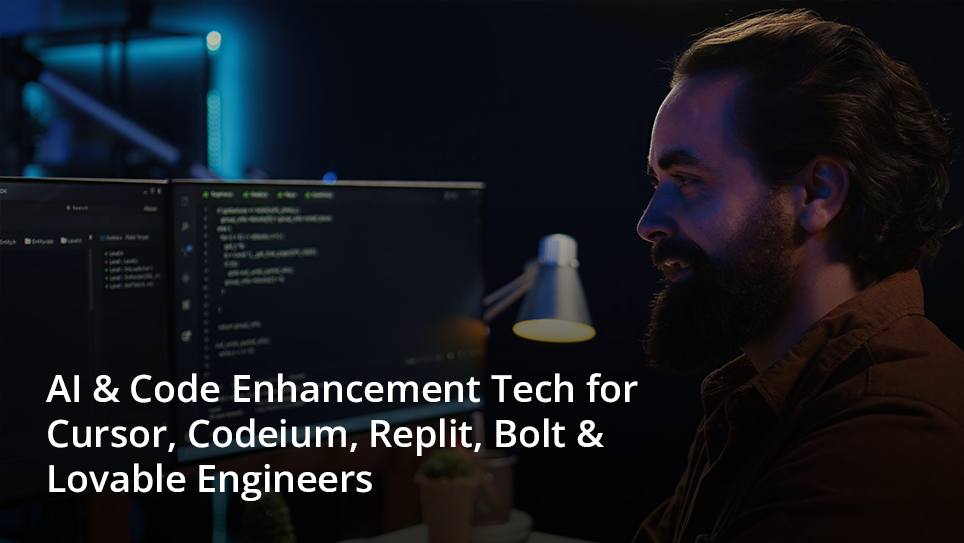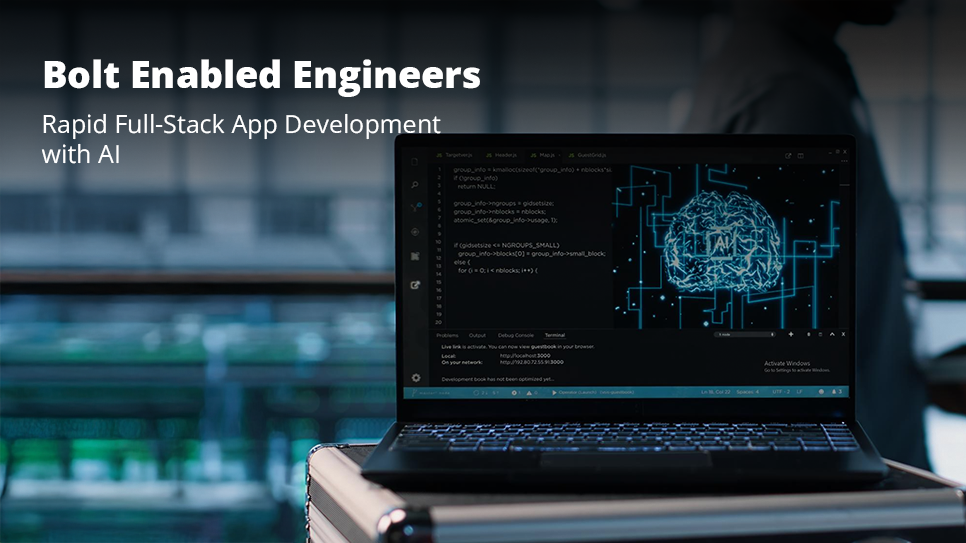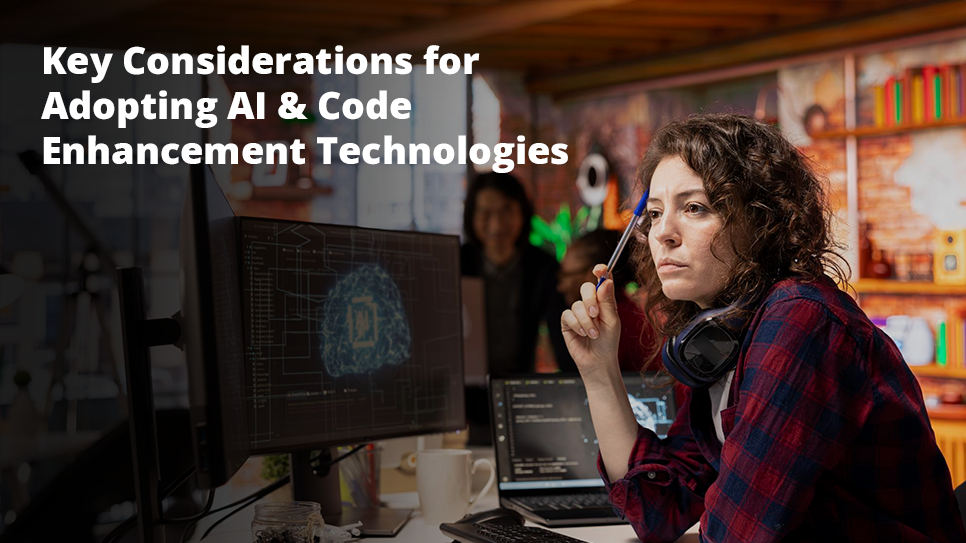AI and Code Enhancement Tech for Cursor, Codeium, Replit, Bolt & Lovable Engineers

In modern software development, AI & Code Enhancement Technologies are becoming integral to how teams write and ship code. A recent industry survey found that 76% of developers expect AI tools to play a crucial role in software projects within the next year. From intelligent code editors to no-code app builders, these tools are enabling unprecedented boosts in productivity and innovation. Engineers empowered by these solutions – whether as Cursor Enabled Engineers, Codeium Enabled Engineers, Replit Enabled Engineers, Bolt Enabled Engineers, or Lovable Enabled Engineers – are achieving faster development cycles and smarter workflows by leveraging AI-driven assistance in coding.
Today’s CTOs and engineering leaders are evaluating how such AI & Code Enhancement Technologies fit into their organizations. The motivations are clear: gaining a competitive edge through faster execution, accelerating delivery to market, and fostering technical excellence by reducing repetitive work. In this blog, we will explore five leading platforms (Cursor, Codeium, Replit, Bolt, and Lovable) and how they empower different kinds of “AI-enabled” engineers. We’ll also highlight real-world examples and key considerations for adopting these tools in enterprise settings.
Cursor Enabled Engineers – AI-First Coding with Cursor’s Intelligent Editor
For Cursor-Enabled Engineers, the Cursor platform offers an AI-first code editor that seamlessly integrates AI into the development workflow. Cursor is essentially a modern IDE supercharged with AI capabilities. It provides context-aware code completions and the ability to edit code using natural language instructions, allowing engineers to update entire functions or classes with a simple prompt. This means an engineer can say, for example, “add input validation to this function,” and Cursor will intelligently modify the code accordingly, all within the familiar environment of a VS Code-like editor.
What sets Cursor apart is its focus on productivity and deep codebase integration. It can index your entire project to answer questions about your code or suggest relevant snippets from elsewhere in the repository. The tool’s “Tab” key completions often feel like magic – one user observed that about 25% of the time, Cursor anticipates exactly what he intends to write next. In practice, Cursor-enabled engineers find that they are “typing ‘Tab’ more than anything else,” essentially letting the AI fill in multiple lines of code so they can code at the speed of thought.
Security and privacy are also considered in Cursor’s design – a Privacy Mode ensures code stays local (Cursor is SOC 2 certified). This is crucial for enterprise use in sensitive projects. By blending into existing workflows (developers can import their preferred VS Code extensions and settings) and iterating with rapid feature improvements, Cursor has quickly become a go-to AI coding tool for many professionals.
Codeium Enabled Engineers – AI Autocomplete Across Your IDEs
While Cursor provides a standalone AI-centric IDE, Codeium brings AI & Code Enhancement Technologies into whatever IDE or code editor engineers already use. Codeium Enabled Engineers harness this AI-powered code completion tool as a plugin in environments ranging from VS Code and JetBrains IDEs to Vim/Neovim and even Jupyter notebooks. Codeium (recently rebranded as Windsurf for its next-gen editor) is essentially an AI autocomplete and coding assistant that works across 40+ IDEs and supports over 70 programming languages, making it one of the most universal solutions in this space.
The core of Codeium’s value is its contextual intelligence. It analyzes not only the current file a developer is editing, but also the broader codebase and even multiple open files to generate precise, context-aware suggestions. This leads to highly relevant code completions that can significantly accelerate development while reducing errors.
In summary, Codeium brings the power of AI assistance into developers’ everyday coding tools. It enables engineers to “dream bigger and write more” by handling the rote parts of coding, allowing them to focus on complex logic and creative problem solving. A Codeium Enabled Engineer can effortlessly autocomplete large blocks of code, find and fix issues via AI chat, and even generate entire functions on command – all within their preferred IDE, which remains a compelling proposition for boosting team productivity.
Also Read:- Entering an AI-led Era of Recruitment: How Tech Can Optimize Value and Remain Human-Centered
Replit Enabled Engineers – Cloud Collaboration and AI Agents
Replit takes a somewhat different approach in the landscape of AI & Code Enhancement Technologies. It is a cloud-based development platform that combines coding, hosting, and collaboration, now augmented with powerful AI capabilities. Replit Enabled Engineers leverage a unified environment where code can be written and executed in the browser, shared in real time, and enhanced by AI features such as Replit’s Ghostwriter and the newer Replit AI “Agent.” The result is a development workflow that is extremely fast and accessible, from a proof-of-concept to a deployed application, all without leaving the platform.
One of Replit’s pioneering features was Multiplayer Mode, which allows multiple developers to edit code simultaneously in a shared workspace. Building on that collaborative ethos, Replit introduced Ghostwriter, an AI pair programmer integrated into the IDE that can autocomplete code, explain code snippets, transform code from one style to another, and even answer questions within the editor.
Replit’s impact is evident in its massive community: the platform now counts over 30 million developers worldwide using it to build applications of all kinds. This wide adoption signals a level of maturity and trust – both hobbyists and professional engineers are comfortable using Replit for serious projects. For enterprises, Replit can serve as an innovation sandbox where teams quickly spin up prototypes collaboratively, or even as a learning/training environment, given its low-friction setup.
Bolt Enabled Engineers – Rapid Full-Stack App Development with AI

Moving from coding assistants to generative development platforms, Bolt is a standout entrant that focuses on turning natural-language prompts into full-stack applications. Bolt-enabled engineers are often product-minded developers or even startup founders who want to go from idea to a working prototype quickly, without getting bogged down in boilerplate setup. Bolt (accessible via bolt.new) leverages AI to generate an entire codebase for web or mobile applications based on user prompts. This includes not just static code generation, but an iterative process where you can refine the prompt or provide feedback, and Bolt will update the application accordingly.
One way to think of Bolt is as an “AI software engineer” that you can instruct in plain language. For example, if you tell Bolt, “Build a clone of Spotify with a music library and playback features,” the platform will begin creating the project structure, files, and even UI components needed for a Spotify-like app.
It’s worth noting that Bolt is often compared to Replit’s AI capabilities and other “app generator” tools. One review described Bolt as a game-changer in AI-generated apps, noting its “impressive capabilities” and modern interface. The same review highlighted Bolt’s ability to produce visually appealing designs from simple prompts, which is a boon for those who don’t have a designer on hand.
Lovable Enabled Engineers – No-Code, AI-Driven App Creation for Everyone
At the far end of the spectrum of code enhancement lies Lovable – a platform that truly embodies the promise of no-code development powered by AI. Lovable Enabled Engineers (and indeed, often non-engineers) can take an idea for an application and have a working solution generated without writing any code themselves. Branded with the tagline “Idea to app in seconds, with your full stack engineer”, Lovable is designed to be accessible to users with minimal technical background while still providing meaningful, functional outputs.
Lovable operates through a simple interface where users describe what they want (for instance, “a social media app for sharing travel photos with map locations”) and the platform’s AI builds out the application, including the frontend UI, backend logic, and database setup.
Real-world examples illustrate the power of Lovable. In one case, a Grammy-nominated film producer built an AI-driven filmmaking platform using Lovable without any prior coding experience. In another, a 3D artist leveraged Lovable to create a full SaaS product, turning a personal project into a new career.
However, with the convenience of Lovable comes trade-offs in flexibility. Since it abstracts away the code, heavy customization beyond what the tool allows can be limited. Lovable’s philosophy is to cover the common requirements out-of-the-box – for example, it provides integrations like database (Supabase) support, authentication modules, etc., so that many standard apps can be generated end-to-end.
Key Considerations for Adopting AI & Code Enhancement Technologies

The above tools exemplify how AI is transforming software development – from AI-enabled coding companions (Cursor, Codeium, Ghostwriter) to AI-driven app generators (Bolt, Lovable). As enterprise leaders consider adopting these technologies, there are some important factors to weigh:
- Integration with Existing Workflows: Ensure the tool fits your tech stack and development environment. For example, Codeium’s support for dozens of IDEs means it can likely plug into your team’s existing editors, whereas adopting a new AI-first IDE like Cursor might require training and workflow adjustments.
- Degree of Control vs. Automation: Identify the right level of abstraction for your needs. If your developers want fine-grained control over every line of code (e.g., in a safety-critical system), a tool like Cursor or an AI assistant in the editor is appropriate.
- Security & Privacy: Evaluate how code and data are handled. AI coding tools often send snippets of code to cloud models. Tools like Cursor offer privacy modes where code stays local, and Codeium provides self-hosted enterprise deployments.
- Developer Training & Adoption: Introducing AI assistance requires change management. Developers should be trained on how to effectively use the new tools (e.g., writing good prompts, reviewing AI-generated code) and warned of their limitations.
- Measuring Impact: Define metrics to track the ROI of these technologies, such as reduction in development cycle time, fewer bugs, or faster prototype completion. Many have reported significant improvements (like 40% less time spent on unit tests in one case after using AI tools), but measuring it in your context will help justify further expansion and guide any process tweaks.
By keeping these considerations in mind, enterprise decision-makers can smoothly integrate AI tools into their software development workflows and maximize the benefits while mitigating risks.
Conclusion
The emergence of AI & Code Enhancement Technologies is reshaping how software is developed across the industry. From Cursor Enabled Engineers doubling their productivity with AI-augmented coding, to Codeium Enabled Engineers leveraging deep context autocomplete in any IDE, to Replit Enabled Engineers collaboratively building and deploying in the cloud with AI agents, the capabilities at hand today would have seemed like science fiction just a few years ago. Meanwhile, Bolt-enabled engineers and Lovable Enabled Engineers are demonstrating that even complex apps can be prototyped with minimal manual coding, opening the door for more innovation from a wider range of contributors.
At FX31 Labs, we have witnessed firsthand how these tools can dramatically accelerate development cycles and enhance software quality when applied thoughtfully. By staying at the forefront of these trends, we aim to guide our partners in selecting and implementing the right tools for their needs, whether it’s an AI pair programmer to assist your development team or a no-code app builder to empower your business units. The key is to view AI platforms as force multipliers: they don’t replace engineers, but they make engineers (and even non-engineers) more productive, creative, and agile in tackling software challenges.
